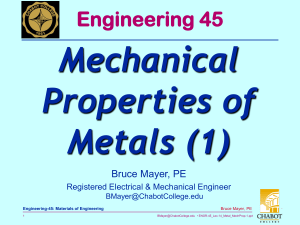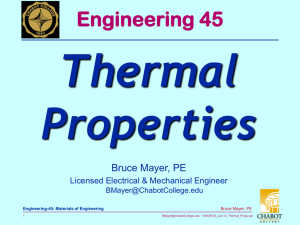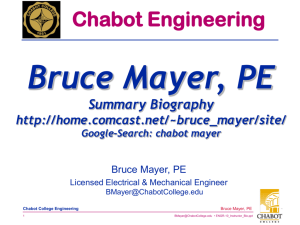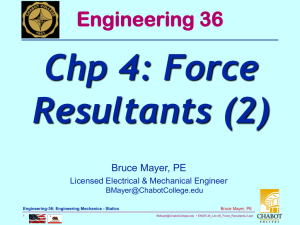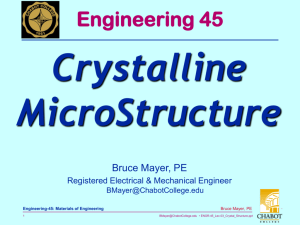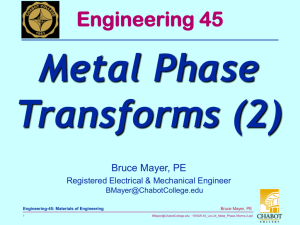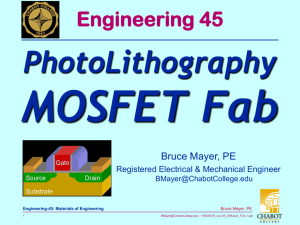ENGR-45_Lec-25_Metal_Apps
advertisement
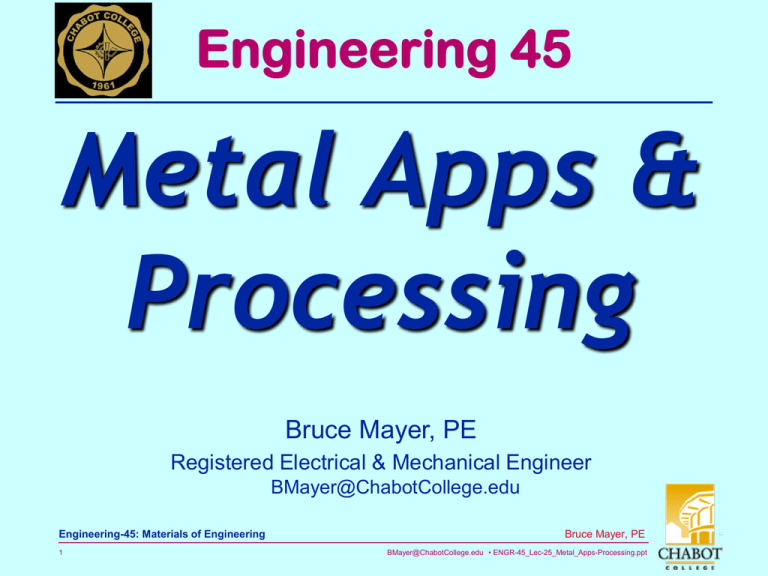
Engineering 45 Metal Apps & Processing Bruce Mayer, PE Registered Electrical & Mechanical Engineer BMayer@ChabotCollege.edu Engineering-45: Materials of Engineering 1 Bruce Mayer, PE BMayer@ChabotCollege.edu • ENGR-45_Lec-25_Metal_Apps-Processing.ppt Learning Goals How Metal Alloys Are Classified Uses for Metal Alloys Understand Common Metal Fabrication Processes (Techniques) How properties can VARY Throughout a SINGLE Piece Of Material • e.g.; as a Result of Quenching How to modify Properties by Post-Processing Heat Treatment Engineering-45: Materials of Engineering 2 Bruce Mayer, PE BMayer@ChabotCollege.edu • ENGR-45_Lec-25_Metal_Apps-Processing.ppt Metal Alloys Ferrous Steels Steels <1.4wt%C <1.4wt%C Nonferrous Cast Irons Cast Irons 3-4.5wt%C 3-4.5wt%C Cu A 1600 d 1200 L 1000 g+L g austenite a800 ferrite 600 400 0 (Fe) Eutectic: 4.30 g+Fe3C a+Fe3C 2 3 4 5 6 6.7 Co, wt% C Engineering-45: Materials of Engineering 3 Fe3C cementite Eutectoid: 1 Metals Family Tree (taxonomy) L+Fe3C 1148°C 727°C 0.77 Ti microstructure: ferrite, graphite cementite T(°C) 1400 Mg Bruce Mayer, PE BMayer@ChabotCollege.edu • ENGR-45_Lec-25_Metal_Apps-Processing.ppt Ferrous v. NonFerrous Defined A Metal Alloy/Compound is Designated as FERROUS if it Contains 50+% Iron EVERY Other Metal is NONFerrous Class Question: Rank these Metals in Terms of WorldWide Production Steel Aluminum Zinc Copper Engineering-45: Materials of Engineering 4 Bruce Mayer, PE BMayer@ChabotCollege.edu • ENGR-45_Lec-25_Metal_Apps-Processing.ppt Global Metal Production - 2001 Metal 106 Tonnes Zinc 7 Copper 12 Aluminum 21 Steel (Ferrous) 788 Engineering-45: Materials of Engineering 5 Bruce Mayer, PE BMayer@ChabotCollege.edu • ENGR-45_Lec-25_Metal_Apps-Processing.ppt Why Ferrous Dominates Ore is cheap and abundant Processing techniques are economical (extraction, refining, alloying, fabrication) High strength Very versatile metallurgy – a wide range of mechanical and physical properties can be achieved, and these can be tailored to the application Engineering-45: Materials of Engineering 6 Bruce Mayer, PE BMayer@ChabotCollege.edu • ENGR-45_Lec-25_Metal_Apps-Processing.ppt Ferrous Disadvantages Low corrosion resistance – Oxidizes (rusts) easily • use e.g. titanium, brass instead High Density: 7900 kg/m3 (0.29 lb/in3) • use e.g. aluminum, magnesium High temperature strength could be better • use nickel instead Engineering-45: Materials of Engineering 7 Bruce Mayer, PE BMayer@ChabotCollege.edu • ENGR-45_Lec-25_Metal_Apps-Processing.ppt BASIC DISTINCTION BASIC DISTINCTION between FERROUS and NONferrous alloys: Ferrous metals are ‘all-purpose’ alloys Non-ferrous metals used for niche applications, where properties of ferrous metals are inadequate Engineering-45: Materials of Engineering 8 Bruce Mayer, PE BMayer@ChabotCollege.edu • ENGR-45_Lec-25_Metal_Apps-Processing.ppt STEELS High Alloy Low Alloy low carbon med carbon high carbon <0.25wt%C 0.25-0.6wt%C 0.6-1.4wt%C heat plain treatable Cr,V Cr, Ni Additions none none none Ni, Mo Mo Example 1018 4310 1040 4340 1095 Hardenability 0 + + ++ ++ TS 0 + ++ + EL + + 0 Name plain HSLA Uses auto struc. sheet bridges towers press. vessels plain pistons wear crank gears shafts applic. wear bolts hammers applic. blades austentitic stainless tool Cr, V, Mo, W 4190 +++ ++ -- Cr, Ni, Mo 304 0 0 ++ drills saws dies increasing strength, cost, decreasing ductility Engineering-45: Materials of Engineering 9 high T applic. turbines furnaces V. corros. resistant Bruce Mayer, PE BMayer@ChabotCollege.edu • ENGR-45_Lec-25_Metal_Apps-Processing.ppt StainLess Steels If metallurgist Harry Brearly, the man credited with the development of STAINLESS steel, had his way we would know this family of alloys as RUSTLESS steel. However, even in 1913, the Cutlery Manager of the Sheffield (England) steel plant where the new alloy was devised, one Earnest Stuart, decided that the name rustless was NO great MARKETING tool. His test for utensils made from this new product was to dip knife blades in vinegar and he noted they STAINED LESS than other metals. Engineering-45: Materials of Engineering 10 Bruce Mayer, PE BMayer@ChabotCollege.edu • ENGR-45_Lec-25_Metal_Apps-Processing.ppt What is Stainless Steel? Must Contain: >10.5% Cr, <1% C The Cr Alloying Creates a Cr2O3 surface Layer that resists oxidation (i.e., rusting) and makes the material "passive" or corrosion resistant (i.e., "stainless"). Three MAIN Branches • Ferritic → Cr Only, BCC • Austenitic → Ni Added, FCC, NONmag • Martensitic → Hard & Brittle Engineering-45: Materials of Engineering 11 Bruce Mayer, PE BMayer@ChabotCollege.edu • ENGR-45_Lec-25_Metal_Apps-Processing.ppt Martensitic StainLess Steels 12 to 18% chromium Basic Characteristics • Are magnetic • Can be Tempered by "heat treatment" • Have "poor" welding characteristics Common Uses • Knife blades • Surgical instruments Engineering-45: Materials of Engineering 12 • Fasteners • Shafts • Springs Grades/Forms • Metallurgical structure Martensitic • Grade: 410 (most used), 420 (cutlery), 440C (for very high hardness) • UNS: S41000, S42000, S44004 Bruce Mayer, PE BMayer@ChabotCollege.edu • ENGR-45_Lec-25_Metal_Apps-Processing.ppt Ferritic StainLess Steel 12 to 18% Cr; <0.2% C Basic Character • Are magnetic • CANNOT be hardened by "heat treatment" – always used in the annealed or softened condition • Poor Weldability Common Uses Engineering-45: Materials of Engineering 13 • Automotive exhaust and fuel lines • Architectural trim • Cooking utensils • Bank vaults Grades/Forms • Metallurgical structure - Ferritic • Grade: 409 (high temperature), 430 (most used) • UNS: S40900, S43000 Bruce Mayer, PE BMayer@ChabotCollege.edu • ENGR-45_Lec-25_Metal_Apps-Processing.ppt Austenitic StainLess Steel Nickel added and the Cr level increased • Structure Stays FCC to Room Temp Basic Character • Are NOT magnetic • CANNOT be hardened by "heat treatment" BUT CAN be hardened by cold working Engineering-45: Materials of Engineering 14 • Have the "BEST" corrosion resistance • Can be easily welded • Have excellent cleanability and hygiene characteristics • Have exceptional resistance to both high and low temperature Bruce Mayer, PE BMayer@ChabotCollege.edu • ENGR-45_Lec-25_Metal_Apps-Processing.ppt Austenitic StainLess Steel cont.1 Common Uses • Kitchen sinks • Architectural applications such as roofs and gutters, doors and windows, tubular frames • Food processing equipment • Restaurant food preparation areas • Chemical Vessels Engineering-45: Materials of Engineering 15 • Ovens/Furnaces • Heat exchangers Grades/Forms • Metallurgical structure - Austenitic • Grade: 304 (most used), 310 (for high temperature), 316 (for better corrosion resistance), 317 (for best corrosion resistance) Bruce Mayer, PE BMayer@ChabotCollege.edu • ENGR-45_Lec-25_Metal_Apps-Processing.ppt Other StainLess Steels Austenitic Grades Forms (cont) • UNS: S30400, S31000, S31600, S31700 Duplex StainLess • MicroStructure is Combination of Ferritic and Austenitic • Typical Composition Engineering-45: Materials of Engineering 16 – Cr = 18 to 26% – Ni = 4-7% – Mo = 2-3% • Common Uses – Sea water applications – Heat exchangers – Desalination plants – Food pickling plants Bruce Mayer, PE BMayer@ChabotCollege.edu • ENGR-45_Lec-25_Metal_Apps-Processing.ppt StainLess Steels Compared Mechanical Properties (Annealed condition) Tensile Strength Stainless ksi MPa 410 70 483 430 75 517 304 84 579 316 84 579 Elongation in 2" (50.80 mm) Hardness in Rockwell B Engineering-45: Materials of Engineering 17 Yield Strength ksi MPa 45 50 42 42 310 345 290 290 Elongation Hardness 25 25 55 50 Bruce Mayer, PE BMayer@ChabotCollege.edu • ENGR-45_Lec-25_Metal_Apps-Processing.ppt B80 B85 B80 B79 NONferrous (No Iron) Alloys • Cu Alloys • Al Alloys Brass: Zn is subst. impurity -lower : 2.7g/cm 3 (costume jewelry, coins, -Cu, Mg, Si, Mn, Zn additions corrosion resistant) -solid sol. or precip. Bronze: Sn, Al, Si, Ni are strengthened (struct. subst. impurity aircraft parts (bushings, landing & packaging) gear) • Mg Alloys NonFerrous Cu-Be: -very low : 1.7g/cm 3 Alloys precip. hardened -ignites easily for strength -aircraft, missles • Ti Alloys -lower : 4.5g/cm 3 • Refractory metals -high melting T -Nb, Mo, W, Ta vs 7.9 for steel • Noble metals -reactive at high T -Ag, Au, Pt -oxid./corr. resistant -space applic. Engineering-45: Materials of Engineering 18 Bruce Mayer, PE BMayer@ChabotCollege.edu • ENGR-45_Lec-25_Metal_Apps-Processing.ppt Process: Iron Ore → Steel Iron Ore gas refractory vessel layers of coke and iron ore air slag Molten iron Engineering-45: Materials of Engineering 19 Coke Limestone BLAST FURNACE heat generation C+O2 CO2 reduction of iron ore to metal CO2 +C 2CO 3CO+Fe 2O3 2Fe+3CO 2 purification CaCO 3 CaO+CO 2 CaO + SiO 2 +Al2O3 slag Bruce Mayer, PE BMayer@ChabotCollege.edu • ENGR-45_Lec-25_Metal_Apps-Processing.ppt Metal Fabrication Methods-I CASTING FORMING • Forging • Rolling (wrenches, crankshafts) (I-beams, rails) force die Ao blank Ad often at elev. T • Drawing force • Extrusion (rods, wire, tubing) die Ao Ad die Engineering-45: Materials of Engineering 20 JOINING Adapted from Fig. 11.7, Callister 6e. (rods, tubing) tensile force Bruce Mayer, PE BMayer@ChabotCollege.edu • ENGR-45_Lec-25_Metal_Apps-Processing.ppt 6 Forming (Working) Temperature Hot Working Cold Working • recrystallization • less energy to deform • Oxidation poor finish • lower strength • Strain Hardens • More Energy to Deform • Little Oxidation • Better Dim Control Forged Frature Cold Working → AnIsotropic MicroStrucure Engineering-45: Materials of Engineering 21 Swaged Bruce Mayer, PE BMayer@ChabotCollege.edu • ENGR-45_Lec-25_Metal_Apps-Processing.ppt Metal Fabrication Methods-II FORMING CASTING • Sand Casting (large parts, e.g., auto engine blocks) • Investment Casting (low volume, complex shapes e.g., jewelry, turbine blades) plaster die formed around wax prototype Engineering-45: Materials of Engineering 22 JOINING • Die Casting (high volume, low T alloys) • Continuous Casting (simple slab shapes) molten solidified Bruce Mayer, PE BMayer@ChabotCollege.edu • ENGR-45_Lec-25_Metal_Apps-Processing.ppt Metal Fabrication Methods-III FORMING • Powder Processing (materials w/low ductility) pressure heat area contact CASTING JOINING • Welding (when one large part is impractical) filler metal (melted) basemetal (melted) fused base metal heat affected zone unaffected unaffected piece 1 piece 2 densify • Heat affected zone: point contact at low T densification by diffusion at higher T Engineering-45: Materials of Engineering 23 (region in which the microstructure has been changed). Bruce Mayer, PE BMayer@ChabotCollege.edu • ENGR-45_Lec-25_Metal_Apps-Processing.ppt Metals - Thermal Processing ANNEALING Heat to Tanneal, then Cool Slowly •Stress Relief : Reduce stress caused by: -plastic deformation -nonuniform cooling -phase transform. • Spheroidize (steels): Make very soft steels for good machining. Heat just below T E & hold for 15-25h. Types of Annealing •Process Anneal : Negate effect of cold working by (recovery/ recrystallization) Engineering-45: Materials of Engineering 24 • Full Anneal (steels): Make soft steels for good forming by heating to get g, then cool in furnace to get coarse P. •Normalize (steels): Deform steel with large grains, then normalize to make grains small. Bruce Mayer, PE BMayer@ChabotCollege.edu • ENGR-45_Lec-25_Metal_Apps-Processing.ppt Steel Heat Treating 800 Austenite (stable) T(°C) TE A P a) Annealing • Forms Pearlite b) Quenching • Tempers toward Spheroidite Engineering-45: Materials of Engineering 25 B A 400 Forms Martensite c) Tempering Martensite • 600 0% M+A 200 50% M+A 90% a) b) 10 -1 10 10 3 time (s) Bruce Mayer, PE BMayer@ChabotCollege.edu • ENGR-45_Lec-25_Metal_Apps-Processing.ppt 10 5 c) Hardenability - Steels Depends on Ability to form martensite Jominy end quench test to measure Hardenability 1” 4” Hardness, HRC specimen (heated to g phase field) 24°C water flat ground RockWell Hardness Hardness versus distance from the quenched end Distance from quenched end Engineering-45: Materials of Engineering 26 Bruce Mayer, PE BMayer@ChabotCollege.edu • ENGR-45_Lec-25_Metal_Apps-Processing.ppt Hardness, HRC Jominy-Hardness vs Position 60 Misses A→P Band; All g Turns to Martensite 40 20 0 1 2 distance from quenched end (in) 3 T(°C) 0% 100 % 600 400 200 Passes Completely Thru the A→P Band at Lower-T, Yielding 100%, and Finer, Pearlite M(start) A M 0 M(finish) 0.1 1 Passes Completely Thru the A→P Band at Higher-T, Yielding 100%, and Coarser Pearlite 10 100 1000 Time (s) Engineering-45: Materials of Engineering 27 Partially Intersects A→P Band. About 20% of g forms Pearlite; the Remaining 80% forms Martensite Bruce Mayer, PE BMayer@ChabotCollege.edu • ENGR-45_Lec-25_Metal_Apps-Processing.ppt Hardenability vs Composition Jominy End-Quench Test for 0.4%C Stl Hardness, HRC Cooling rate (°C/s) 100 10 3 2 60 40 T(°C) 600 A 400 100 4340 800 80 %M 50 4140 8640 200 0 -1 10 10 B TE shift from A to B due to alloying M(start) M(90%) 103 105 Time (s) “Alloy Steels“ • contain Ni, Cr, Mo (0.2 to 2wt%) • These elements shift the "nose“ of A→P Band • 4140, 4340, 5140, 8640 Engineering-45: Materials of Engineering • Martensite is easier to Form with alloying Bruce Mayer, PE 5140 20 0 10 20 30 40 50 Distance from quenched end (mm) 28 BMayer@ChabotCollege.edu • ENGR-45_Lec-25_Metal_Apps-Processing.ppt Quenching Medium & Geometry Effect of Quenching Medium Medium air oil water Severity of Quench small moderate large Hardness small moderate large Effect of Geometry → When Surface:Volume Ratio Increases • COOLING RATE and HARDNESS INcreases Position Cooling rate center small surface large Engineering-45: Materials of Engineering 29 Hardness small large Bruce Mayer, PE BMayer@ChabotCollege.edu • ENGR-45_Lec-25_Metal_Apps-Processing.ppt Precipitation Hardening Concept: Particles Impede Dislocations • e.g.; Al-Cu System Procedure • Pt A: Solution heat treat – All θ Disolves (goes into Solution) to Form α-Only • Pt B: Quench to Room Temperature – Freeze in the α-Only Structure SuperSaturated α Engineering-45: Materials of Engineering 30 • Pt C: Precipitation – Reheat to nucleate small θ crystals within α Matrix Bruce Mayer, PE BMayer@ChabotCollege.edu • ENGR-45_Lec-25_Metal_Apps-Processing.ppt Precipitation Hardening cont. Time-Temperature Plot for Age (Precipitation) Hardening Temp.Pt A (sol’n heat treat) Pt C (precipitate θ) Time Pt B Other Age Hardening Alloy Systems • Cu-Be • Cu-Sn • Mg-Al Engineering-45: Materials of Engineering 31 Bruce Mayer, PE BMayer@ChabotCollege.edu • ENGR-45_Lec-25_Metal_Apps-Processing.ppt Age Hardened Properties Example = 2014 Al → 4%-Cu Alloyed 500 400 300 149°C 204°C 200 1min 1h 1day 1mo 1yr precipitation heat treat time (h) • σu Peaks with Precipitation Time Engineering-45: Materials of Engineering 32 %EL (2in sample) tensile strength (MPa) 30 20 10 204°C 149°C 0 1min 1h 1day 1mo 1yr precipitation heat treat time (h) • %EL reaches minimum with precipitation time • Increasing T accelerates Ageing process Bruce Mayer, PE BMayer@ChabotCollege.edu • ENGR-45_Lec-25_Metal_Apps-Processing.ppt Over Ageing → Lg Precipitates Optimum Ageing Yields Fine Dispersion of Precipitates Engineering-45: Materials of Engineering 33 Over-Ageing Results in Agglomeration of Precipitates Bruce Mayer, PE BMayer@ChabotCollege.edu • ENGR-45_Lec-25_Metal_Apps-Processing.ppt OverAging Explained – Al/Cu a a a Engineering-45: Materials of Engineering 34 Bruce Mayer, PE BMayer@ChabotCollege.edu • ENGR-45_Lec-25_Metal_Apps-Processing.ppt Aluminum Soln/Age Tempers Engineering-45: Materials of Engineering 35 Bruce Mayer, PE BMayer@ChabotCollege.edu • ENGR-45_Lec-25_Metal_Apps-Processing.ppt Summary – Apps & Processing Steels: Increase σu, Hardness (and cost) by adding • C (low alloy steels) • Cr, V, Ni, Mo, W (high alloy steels) • Ductility usually DEcreases w/additions Non-ferrous Alloys: • Cu, Al, Ti, Mg, Refractory, Noble metals Fabrication techniques: • forming, casting, joining Engineering-45: Materials of Engineering 36 Bruce Mayer, PE BMayer@ChabotCollege.edu • ENGR-45_Lec-25_Metal_Apps-Processing.ppt Summary – Apps & Processing Hardenability • Increases With Alloy Content Precipitation hardening • effective means to Increase Strength in Al, Cu, and Mg alloys. Engineering-45: Materials of Engineering 37 Bruce Mayer, PE BMayer@ChabotCollege.edu • ENGR-45_Lec-25_Metal_Apps-Processing.ppt WhiteBoard Work None Today See Appendices • UNS and SuperAlloys • Cast Iron Microstructure of Rene 80 precipitation hardening nickel alloy showing intergranular carbide particles (white irregular areas) and brown, gamma prime particles in the nickel alloy base metal. Kallings Etch, 400X Engineering-45: Materials of Engineering 38 Bruce Mayer, PE BMayer@ChabotCollege.edu • ENGR-45_Lec-25_Metal_Apps-Processing.ppt Engineering 45 - Appendix UNS SuperAlloys Bruce Mayer, PE Licensed Electrical & Mechanical Engineer BMayer@ChabotCollege.edu Engineering-45: Materials of Engineering 39 Bruce Mayer, PE BMayer@ChabotCollege.edu • ENGR-45_Lec-25_Metal_Apps-Processing.ppt Unified Numbering System The UNS establishes a series of designations for metals and alloys. Each UNS designation consists of a SINGLE-LETTER prefix followed by FIVE digits. In most cases the letter is suggestive of the family of metals identified: for example, F for cast irons, T for tool steel, S for stainless steels. Engineering-45: Materials of Engineering 40 Bruce Mayer, PE BMayer@ChabotCollege.edu • ENGR-45_Lec-25_Metal_Apps-Processing.ppt UNS Series Descriptions UNS Series Metal System A00001 to A99999 Aluminum and Al Alloys C00001 to C99999 Copper and copper alloys D00001 to D99999 Specified mech. property steels E00001 to E99999 Rare earth and rare earthlike metals and alloys F00001 to F99999 Cast irons G00001 to G99999 AISI and SAE carbon and alloy steels H00001 to H99999 AISI and SAE H-steels J00001 to J99999 Cast steels Engineering-45: Materials of Engineering 41 Bruce Mayer, PE BMayer@ChabotCollege.edu • ENGR-45_Lec-25_Metal_Apps-Processing.ppt UNS Series Descriptions UNS Series Metal System K00001 to K99999 Miscellaneous steels and ferrous alloys L00001 to L99999 Low-melting metals and alloys M00001 to M99999 Miscellaneous nonferrous metals and alloys N00001 to N99999 Nickel and nickel alloys P00001 to P99999 Precious metals and alloys R00001 to R99999 Reactive and refractory metals and alloys Engineering-45: Materials of Engineering 42 Bruce Mayer, PE BMayer@ChabotCollege.edu • ENGR-45_Lec-25_Metal_Apps-Processing.ppt UNS Series Descriptions UNS Series Metal System S00001 to S99999 Heat and corrosion resistant (stainless) steels T00001 to T99999 Tool steels, wrought and cast W00001 to W99999 Welding filler metals Z00001 to Z99999 Zinc and zinc alloys Engineering-45: Materials of Engineering 43 Bruce Mayer, PE BMayer@ChabotCollege.edu • ENGR-45_Lec-25_Metal_Apps-Processing.ppt UNS For Low Carbon Steels Consider the UNS G-Series → AISI and SAE carbon and alloy steels These Steels have Nine SubGroups Based on the Primary Alloying Element • 1 - Plain Carbon (not an alloy steel) • 2 - Nickel • 6 - Chromium and Vanadium • 7 – Tungsten • 3 - Chromium and Nickel • 4 – Molybdenum • 8 - Nickel, Chromium and Molybdenum • 9 - Silicon and Manganese • 5 - Chromium Engineering-45: Materials of Engineering 44 Bruce Mayer, PE BMayer@ChabotCollege.edu • ENGR-45_Lec-25_Metal_Apps-Processing.ppt UNS Embedded Info Sometimes but Not Always, the UNS Number contains Alloying Information For the Low Carbon Steels in Particular G10400 = G 1 0 40 0 carbon and alloy steels Future Use Plain Steel 0% Alloying Engineering-45: Materials of Engineering 45 0.40% Carbon Bruce Mayer, PE BMayer@ChabotCollege.edu • ENGR-45_Lec-25_Metal_Apps-Processing.ppt AISI/SAE↔UNS X-Consistency AISI 1095 = UNS G10950 AISI 4340 = UNS G43400 etc. Engineering-45: Materials of Engineering 46 Bruce Mayer, PE BMayer@ChabotCollege.edu • ENGR-45_Lec-25_Metal_Apps-Processing.ppt NONferrous Metals Commercially Significant Non-IronBased Metals Aluminum and its Alloys Gold Beryllium Indium Cobalt and its Alloys Iridium Cobalt Based SuperAlloys Copper and its Alloys Engineering-45: Materials of Engineering 47 Hafnium Lead and its Alloys Magnesium and Alloys Bruce Mayer, PE BMayer@ChabotCollege.edu • ENGR-45_Lec-25_Metal_Apps-Processing.ppt NONferrous Metals cont.1 Commercially Significant Non-Iron-Based Metals Molybdenum Ruthenium Nickel and Alloys Silver Nickel Based SuperAlloys Tantalum Osmium Tin and its Alloys Platinum Titanium and its Alloys Rhenium Thorium Rhodium Engineering-45: Materials of Engineering 48 Bruce Mayer, PE BMayer@ChabotCollege.edu • ENGR-45_Lec-25_Metal_Apps-Processing.ppt NONferrous Metals cont.2 Commercially Significant Non-IronBased Metals Tungsten Vanadium Zinc and its alloys Zirconium and its Alloys • Zr has Very Low Neutron Cross-Section – Use as Nuclear Fuel Rods Engineering-45: Materials of Engineering 49 Bruce Mayer, PE BMayer@ChabotCollege.edu • ENGR-45_Lec-25_Metal_Apps-Processing.ppt SuperAlloys Three Main Types • Cobalt-Based • Nickel Based • Nickel+Iron Based – Less Expensive Major Alloying Element = Cr Other Significant Alloying Elements = Mo, Al Engineering-45: Materials of Engineering 50 Performance • Able to maintain high strengths at high temperatures • Good corrosion and oxidation resistance at high temperatures (Cr, Al) • Good resistance to creep and rupture at high temperatures Bruce Mayer, PE BMayer@ChabotCollege.edu • ENGR-45_Lec-25_Metal_Apps-Processing.ppt Ni-Based SuperAlloys Since 1950, these alloys have predominated in the range 750-980°C • Due to the presence of very stable g’ ordered FCC precipitate (Ni3Al,Ti) – g’ provides high temperature strength thru the Precipitation-Strengthening Mechanism The g’ phase in Co-based superalloys dissolves at 815-1050°C Engineering-45: Materials of Engineering 51 Bruce Mayer, PE BMayer@ChabotCollege.edu • ENGR-45_Lec-25_Metal_Apps-Processing.ppt Co-Based SuperAlloys Exhibit superior hot corrosion and strength characteristics at temperatures 980-1100°C Operating temperatures of the turbine and combustion section Co-based alloys sometimes used in the lower range of 750°C in preference to Ni-based superalloys Can be air or argon cast and are less expensive than the vacuum-processed Nickel alloys Engineering-45: Materials of Engineering 52 Bruce Mayer, PE BMayer@ChabotCollege.edu • ENGR-45_Lec-25_Metal_Apps-Processing.ppt SuperAlloy Examples Haynes-25 = L605 = UNS R30605 Chemical Analysis of Haynes 25™ (UNS R30605) C MN P .05 -.15 1.0 -2.0 S Si .4 .03 .4 Cr Ni 19.0 -21.0 9.0 -11.0 Alloy L605 Mo Cu Co Cb Ti Al Fe W 3.0 bal Other 14.0 -16.0 • Haynes 25™ has an excellent temperature strength and oxidation resistance to 2000 ºF. Inconel 601 = UNS N06601 Chemical Analysis of Inconel 601® (UNS N06601) C MN .05 .3 P S Si Cr Ni .2 22.5 61.5 Mo Cu Co 5 Cb+Ta Ti Al Fe 1.4 14.1 Other Other • Inconel 601® is a standard engineering material and has a great resistance to heat and corrosion. Inconel 601® also has high strength and good workability. Inconel 601® can be used in the heat-treating industry for muffles, furnace components, and for heat-treating baskets and trays. Engineering-45: Materials of Engineering 53 Bruce Mayer, PE BMayer@ChabotCollege.edu • ENGR-45_Lec-25_Metal_Apps-Processing.ppt Aluminum Alloy Numbering Consider Al Alloy UNS A13560 • First Digit (A) – An alpha indicator of base metal. Always A for aluminum • Second Digit (1) – Indicates a modification of the original alloy • Third Digit (3) 2XX Copper 8XX Tin – Designates alloy family 5XX Magnesium 3XX Si w/ Cu and/or Mg 6XX Unused 9XX Others 4XX Silicon 7XX Zinc Engineering-45: Materials of Engineering 54 Bruce Mayer, PE BMayer@ChabotCollege.edu • ENGR-45_Lec-25_Metal_Apps-Processing.ppt Aluminum Alloy No.s cont. Consider Al Alloy UNS A13560 • Fourth and Fifth Digits (56) – Assigned ID number for the particular alloy • Sixth Digit (0) – 0 Casting Specification – 1 Ingot Specification – 2 More Tightly Refined Ingot Specification Engineering-45: Materials of Engineering 55 Bruce Mayer, PE BMayer@ChabotCollege.edu • ENGR-45_Lec-25_Metal_Apps-Processing.ppt Aluminum Alloy Examples Aluminium 6061-T6 = UNS A96061 Component Wt. % Component Wt. % Component Wt. % Al 95.8 - 98.6 Mg 0.8 - 1.2 Si 0.4 - 0.8 Cr 0.04 - 0.35 Mn Max 0.15 Ti Max 0.15 Cu 0.15 - 0.4 Other, each Max 0.05 Zn Max 0.25 Fe Max 0.7 Other, total Max 0.15 • Material Notes: General 6061 characteristics and uses: Excellent joining characteristics, good acceptance of applied coatings. Combines relatively high strength, good workability, and high resistance to corrosion; widely available. The T8 and T9 tempers offer better chipping characteristics over the T6 temper. • Applications: Aircraft fittings, camera lens mounts, couplings, marines fittings and hardware, electrical fittings and connectors, decorative or misc. hardware, hinge pins, magneto parts, brake pistons, hydraulic pistons, appliance fittings, valves and valve parts; bike frames Engineering-45: Materials of Engineering 56 Bruce Mayer, PE BMayer@ChabotCollege.edu • ENGR-45_Lec-25_Metal_Apps-Processing.ppt All Done for Today Progress Against Jet Engine Turbine Blade CREEP Blade made out of a nickel-base superalloy with polycrystalline a microstructure The creep life of the blades is limited by the grain boundaries which are deformation paths. Blade made out of a nickelbase superalloy tha has been directionally-solidified, resulting in a columnar grain structure which mitigates grain-boundary induced creep. Blade made out of a nickelbase superalloy that has been Spiral-solidified, resulting in a single grain structure which eliminates grain-boundary induced creep. Bruce Mayer, PE Engineering-45: Materials of Engineering 57 Blade is directionallysolidified via a SPIRAL SELECTOR, which permits only ONE crystal to grow into the blade. BMayer@ChabotCollege.edu • ENGR-45_Lec-25_Metal_Apps-Processing.ppt http://www.metallography.com/types.htm Iron Ore to Steel To produce steel, the first step is to make what is called pig iron. Alternating layers of iron ore, limestone (a mineral used to purify the mixture), and coke (coal that has been prepared specially for this process) are poured into a blast furnace. Hot air at 1200 degrees F is then blasted through the exhaust vent to create the combustion process. The coke then burns the mixture at 3000 degrees F and two reactions occur. The first reaction is when the carbon from coke and the oxygen from the air combine to liberate the metallic iron and make it liquid, directing it to the bottom of the furnace. The second reaction is when the limestone attracts the impurities. These impurities float to the top of the melted pig iron and is siphoned off as slag. Every few hours, the melted pig iron is removed from the bottom of the furnace and further processed. Pig iron contains 4 to 5% carbon which makes it much too brittle to be used as is. Reducing the extra carbon in the pig iron will convert it to steel. This process is called "refining". Just as crude oil is refined into gasoline or kerosene pig iron is refined into steel. Refining pig iron into steel by reduction of the the carbon by the “basic oxygen” furnace steel making process. In this process, the amount of carbon is decreased by regulating the amount of oxygen that is injected into the pig iron. The oxygen removes the unwanted carbon by oxidation. This unwanted carbon, together with a mixture of other impurities constitutes the slag and is removed from the furnace. COKE = mosly Coal → C-H solid Engineering-45: Materials of Engineering 58 Bruce Mayer, PE BMayer@ChabotCollege.edu • ENGR-45_Lec-25_Metal_Apps-Processing.ppt Engineering 45 - Appendix - Cast Iron Bruce Mayer, PE Licensed Electrical & Mechanical Engineer BMayer@ChabotCollege.edu Engineering-45: Materials of Engineering 59 Bruce Mayer, PE BMayer@ChabotCollege.edu • ENGR-45_Lec-25_Metal_Apps-Processing.ppt Cast Iron Summary Ferrous alloys with > 2.1 wt% C • more commonly 3 - 4.5 wt%C low melting Temperature (also brittle) so easiest to cast Cementite decomposes to ferrite + graphite • Fe3C →3Fe (α) + C (graphite) – generally a slow process Engineering-45: Materials of Engineering 60 Bruce Mayer, PE BMayer@ChabotCollege.edu • ENGR-45_Lec-25_Metal_Apps-Processing.ppt True Fe-C Equilibrium Diagram T(°C) “Graphite formation promoted by • • 1600 L 1400 Si > 1 wt% slow cooling g Austenite 1200 Liquid + Graphite g +L 1153°C 4.2 wt% C 1000 g + Graphite ag 800 0.65 740°C 600 400 (Fe) Engineering-45: Materials of Engineering 61 a + Graphite 0 1 2 3 90 4 Co , wt% C Bruce Mayer, PE BMayer@ChabotCollege.edu • ENGR-45_Lec-25_Metal_Apps-Processing.ppt 100 Types of Cast Iron Gray Cast Iron • graphite flakes • weak & brittle under tension • stronger under compression • excellent vibrational dampening • wear resistant Ductile Cast Iron • add Mg or Ce • graphite in nodules not flakes • matrix often pearlite - better ductility Engineering-45: Materials of Engineering 62 Bruce Mayer, PE BMayer@ChabotCollege.edu • ENGR-45_Lec-25_Metal_Apps-Processing.ppt Types of Cast Iron White Iron • <1wt% Si so harder but brittle • more cementite Malleable Iron • heat treat at 800-900ºC • graphite in rosettes • more ductile • graphite in nodules not flakes • matrix often pearlite - better ductility Engineering-45: Materials of Engineering 63 Bruce Mayer, PE BMayer@ChabotCollege.edu • ENGR-45_Lec-25_Metal_Apps-Processing.ppt Cast Iron Production Engineering-45: Materials of Engineering 64 Bruce Mayer, PE BMayer@ChabotCollege.edu • ENGR-45_Lec-25_Metal_Apps-Processing.ppt

